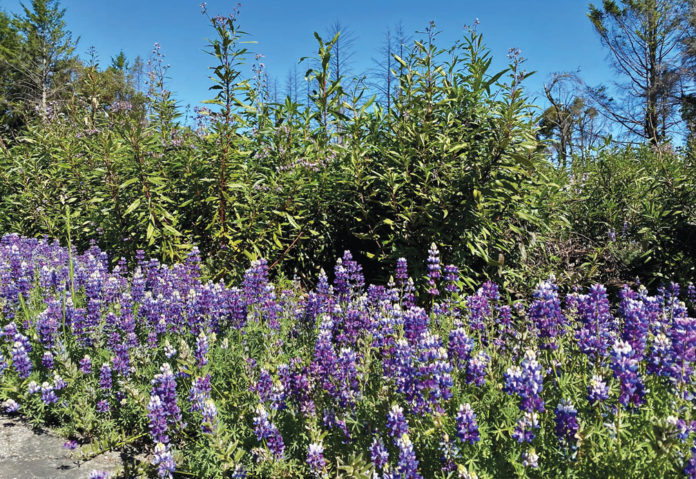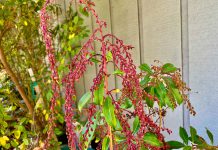My house in Bonny Doon burned down on Aug. 19, 2020. I know this because my neighbor sent me a photo the next day after the fire had moved on down the slope. The next spring quite a few of my plants were making a valiant effort to regrow despite being burned to the ground. I saved about 75 plants that I now call “pets” at my new place in Boulder Creek. So this is a story of survival and renewal.
Mother Nature has millennia to recover from a forest fire. Us, not so much. Much of the 86,000 acres burned in the CZU Lightning Complex fire is now covered densely with the pioneer native plants yerba santa and Ceanothus thyrsiflorus that thrive in disturbed soils like after a fire. The land will sort itself out in the decades to come. The ceanothus will feed the soil enabling trees to regrow. But for now it might seem too much of a good thing especially for those rebuilding after the fire. These are some of the things I’ve learned about fire and renewal.
Ceanothus is so beautiful in the spring, forming lovely clusters of blue and white flowers that produce many seeds. Birds and other wildlife love them. The heat from the fire triggered dormant seeds in the soil to germinate in large numbers. The post-fire conditions, with plenty of light and minimal competition, are ideal for the growth of woody shrubs and this dense shrub layer has rapidly grown over your head in many areas, especially Big Basin.
As a native species, ceanothus plays an important role after a fire but it may also increase wildfire risks. It is relatively short lived. Observations after the 2009 Lockheed fire show that the death of ceanothus as the canopy thickens leads to a significant accumulation of dead woody material in the forest understory. Management will be necessary especially around homes, old growth trees and other important natural resources.
If you are interested in monitoring or managing ceanothus on your property you can reach out to Brian Woodward of the University of California Agriculture and Natural Resources. He has a blog where I found out this valuable information.
Around my old property in Bonny Doon as well as Boulder Creek, native California yerba santa has taken over. It germinates from seed during the first posture growing season. Seeds that have lain dormant in the soil for decades will germinate following a fire. It’s possible that their hard-coated seeds will not germinate except when scarified. So fire may break the seed’s dormancy by burning off the litter layer and exposing the seed to sufficient light to allow germination.
It does provide some forage for our black-tailed deer especially in the winter when more desirable plants are scarce. Deer consumption increases during the first two years following a fire. But now at year 4 after the fire, yerba santa has grown to its full height of 8 feet and is hard to control. Spreading by seed and underground runners it’s taken over many burned properties. The leaves secrete flammable resins and waxes which build up and make the leaf surface gummy. The branches are also glutinous. Older, resinous leaves are dropped during summer producing highly flammable litter.
With shallow roots within the top 8 inches of soil and multi branching rhizomes every 8-10 inches yerba santa is hard to control. It is a diminished survivor and plants gradually die out, however, as the community matures and is displaced in climax communities by chaparral, ceanothus cuneatus, and manzanita.
An interesting fact is that Native Californians used the leaves of yerba santa in the form of a tea to treat respiratory sickness, colds and stomach aches.
Back here in my little garden, my surviving “pets” are blooming and happy. It took a couple of years for the roots to recover after being burned so badly but the stems eventually re-sprouted. I lost all my maples and other trees as only the redwoods survived, but I’m happy that I have flowers for the hummingbirds, and what more can you ask for?
Jan Nelson, a landscape designer and California-certified nursery professional, will answer questions about gardening in the Santa Cruz Mountains. Email her at ja******@*ol.com, or visit jannelsonlandscapedesign.com.













